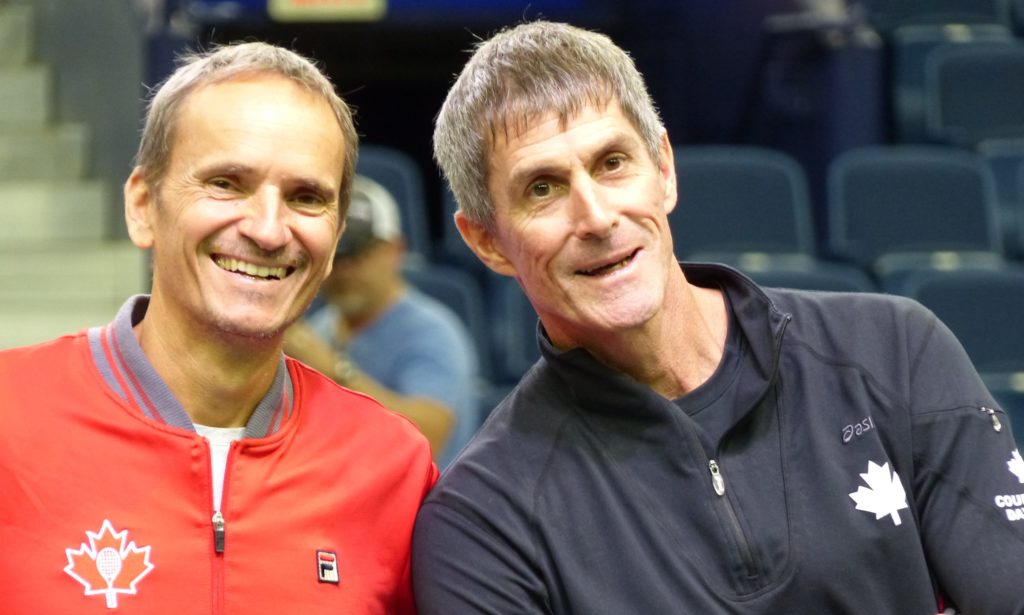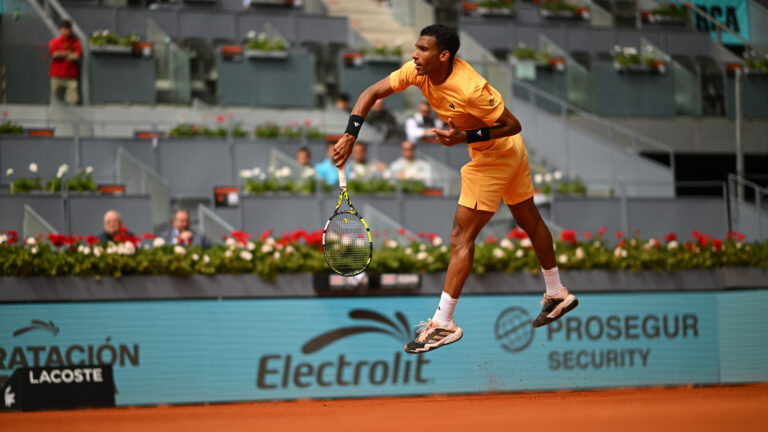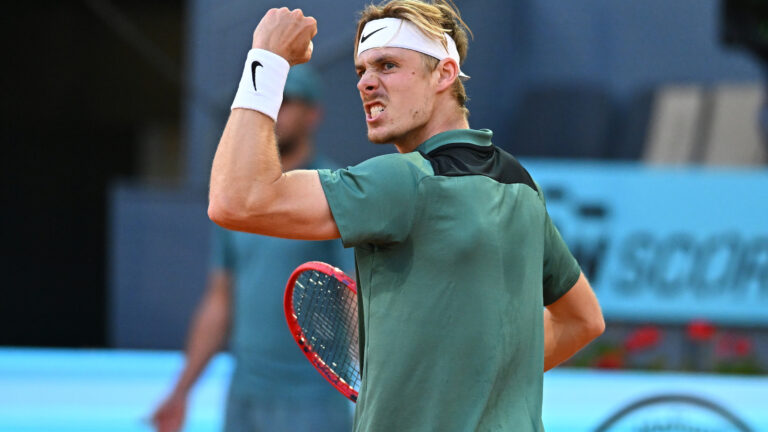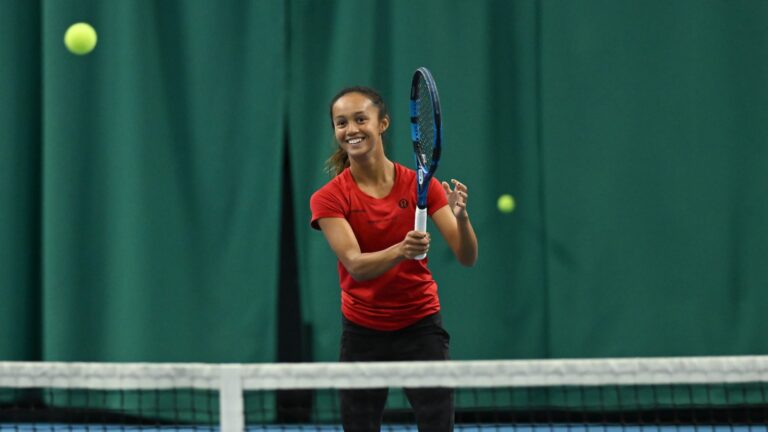
He sits focused and intense in his courtside seat during Davis Cup matches, weighing every possible angle to insure his Canadian team’s success.
Passionate almost to a fault in his position as captain, Martin Laurendeau (above on right with Davis Cup coach Fred Fontang) usually winds up a little teary-eyed at the finish if his team wins – something it has now done 17 the 30 ties he has been involved in as leader.
Rare are the captains as committed and wedded to the cause as the 53-year-old Montrealer whose first tie was in 2004.
Since that time he has been through encounters in several foreign countries such as Mexico (Mexico City), Ecuador (Guayaquil) and Israel (Tel Aviv) – the latter three being cities Canada successfully navigated in 2011 to reach the elite 16-nation World Group. It has maintained that status uninterrupted for the past six years. Make that seven years and counting as of 2018 following a 3-1 victory over India in the World Group Playoffs this past weekend in Edmonton.
Laurendeau’s first tie was in Romania in 2004, a 4-1 loss that put Canada back down into zonal competition after being in the World Group for the third time since the introduction of the Davis Cup format in 1981.
There have been disappointments – tough losses in Japan (2014) and Belgium (2015) with neither Milos Raonic or Vasek Pospisil available to play – but he has also been blessed by the emergence of exceptional talents, Raonic in 2011 and Denis Shapovalov in 2017.

Being a captain isn’t all about whispering nuggets of astute advice in the ears of players like Raonic and Shapovalov as well as other contributors over the years such as Pospisil, Frank Dancevic, Peter Polansky, Philip Bester and the ever-present Daniel Nestor. It’s also doing the little things – checking all the boxes to make sure nothing is missed in trying to maximize his team’s chances of winning.
“When he first took over as captain,” said Tennis Canada’s Davis Cup tournament director Gavin Ziv, “Marty did everything himself right down to getting bananas and uniforms for the players. Things changed when we made the World Group (2012) and then he went on site surveys checking out locker rooms, hotels and sourcing things locally – including a whole foods store for the right food for the players. Team bonding went to a whole new level on the road. No one is more devoted to Davis Cup than Marty.”
And no task is too small or too challenging for Laurendeau who speaks three languages – French, English and Spanish. The latter often came in handy when Canada was stuck in zonal play in South America from 2005 to 2011. An example was in July 2011 in Guayaquil when his team needed a small refrigerator for the cooling vests his players used during change-overs on court. Not the most welcoming city for a Canadian or American, Laurendeau nonetheless ventured out and returned with what was needed. His team then pulled out an inspired 3-2 win after dropping both opening singles matches.
A college player back in the day (the 1980s) as a walk-on at Pepperdine University in Malibu, California, Laurendeau had a solid pro career, reaching a career high of No. 90 in 1988 and making the Round of 16 at the US Open that same year. In terms of Davis Cup participation, he only played in three ties, finding himself just a niche below leading Canadian players of the time such as Glenn Michibata, Martin Wostenholme, Andrew Sznajder and Grant Connell.
As a Davis Cup captain he has managed the gamut of players, with no wider spectrum than this year’s team with its members ranging from Shapovalov, 18, to 45-year-old senior citizen Nestor.

On the court, Laurendeau is tightly-bound energy, jumping up from his chair to encourage and energize his players, and occasionally even taking a back seat as when Pospisil was so far into his bubble in the decisive fifth match in Israel in 2011 that he didn’t want any counsel of any kind from anyone.
A devoted student of the game, Laurendeau has learned from his old college coach at Pepperdine, Allen Fox, who won the 1966 Canadian championship (precursor of the Canadian Open/Rogers Cup) as well as Louis Cayer. He was a fellow-Montrealer who was his coach before going on to be Canadian Davis Cup captain and ultimately a doubles guru with the Lawn Tennis Association in Britain.
In his captain’s position, Laurendeau attends meetings with other Davis Cup captains from around the world to discuss the competition and any changes and innovations that could be coming.

Since the beginning of 2017 he has also been the personal coach of Shapovalov, working with him beginning with training sessions in Australia in January right up through the Davis Cup action in Edmonton this past weekend.
On Tuesday he was scheduled to leave for Prague where he will be with the Richmond Hill teenager at the inaugural Laver Cup event pitting Team Europe against a Team World squad that includes Shapovalov as well as Juan Martin del Potro, Nick Kyrgios, Sam Querrey, John Isner and Jack Sock. That eclectic bunch will be under the captaincy of John McEnroe.
Shapovalov has made astounding advances in 2017 – going from No. 250 at the start of it to his current ATP ranking of No. 51.
When asked about Laurendeau’s influence, he almost always mentions how he has helped with the mental side of the game – getting him to move on immediately from any adversity he may face during matches.
Following his success at Rogers Cup in August – a semi-final finish with wins over No. 31 del Potro and No. 2 Rafael Nadal – and a Round of 16 finish at the US Open as a qualifier with a victory over No. 12 Jo-Wilfried Tsonga, Shapovalov didn’t disappoint this past weekend. He won both his singles matches to lead Canada over India.
“Overall he showed a great presence,” Laurendeau said Sunday in Edmonton about his player. “We can’t forget the guy’s eighteen and he’s got a lot of responsibilities. This is his first time in this position [as Canadian team No. 1 player] and his first five-set match [a win over Yuki Bhambri] was on Friday. He knew he had to go out today and win that point to close off the tie [against Ramkumar Ramanathan] and I thought he handled it really well – played like a veteran.”

Shapovalov, together with Raonic, could well be the anchor of the Canadian Davis Cup team going forward. His next appearance will be in February with a tie against a country and a location to be determined by a draw at the BNP Paribas offices in London on Wednesday at 3 p.m. (10 a.m. ET).
Canada has been fortunate to play (and win) its last four World Group Playoffs (essentially a coin flip) at home – South Africa (2012), Colombia (2014), Chile (2016) and India (2017).
In Wednesday’s draw, the odds may not be as promising as originally expected. A new rule has the two countries in the final – France and Belgium – being given the option of choosing to have a home tie in their first round the following year in February. So Canada would likely not host Belgium or France as would have been the case with the previous home/away alternating system.
Here’s the revised list – with the possibilities of the tie being playing at home, away or having the site determined by a draw.
Great Britain – away Switzerland – draw
France – away Australia – draw
Belgium – away Croatia – draw
Italy – away Serbia – home
The mathematical probability is not good with basically a 63 per cent chance that Canada’s February 2-4 tie will be held on the road. Before revising the Belgian and France ties to away, it was 54 per cent for a home tie.
Laurendeau has an obvious preference. “The first hope is to play at home because we have a pretty good record at home over the last 20 years,” he said on Sunday. “So we can create our conditions of play like here [Edmonton]. It seems to be producing well. The first thing is to play at home. And then we’ll see who we play.”
The worst option would be to be away in France because of that country’s depth. The best option would probably be Switzerland at home because it’s highly unlikely either Roger Federer or Stan Wawrinka would play, especially within just five days of the final at Melbourne Park.
On the subject of Melbourne, Australia would be the ideal pick in terms of convenience because the players could stay in the warmth Down Under right after the Australian Open. In terms of inconvenience for the opposition, Australia might also be the pick – playing somewhere in Canada in frigid February.
The Laver Cup

The inaugural Laver Cup will be held in Prague this weekend featuring Team Europe captained by Swedish great Bjorn Borg vs. Team World captained by American legend John McEnroe.
Team World members are Roger Federer, Rafael Nadal, Marin Cilic, Dominic Thiem, Sasha Zverev and Tomas Berdych. On Team World will be Juan Martin del Potro, Nick Kyrgios, Sam Querrey, Jack Sock, John Isner and Denis Shapovalov.
There are even vice-captains for the three-day event – Thomas Enqvist of Sweden for Team World and baby brother Patrick McEnroe for Team World.
There will be no English language television coverage in Canada but TVA Sports is carrying the event in French: 7 a.m. to 11:30 a.m. on Friday, Sept. 22: 7 a.m. to 7:30 p.m. Saturday Sept. 23: and 6 a.m. to 12:30 p.m. Sunday, Sept. 24. All times are in Eastern Standard Time.
Edmonton Post Card

The Alberta Gallery of Art, founded in 1924 had a major facelift in 2010 with the opening of its innovative new building designed by the late Randall Stout, a Los Angeles-based architect and former associate of the legendary Frank Gehry.
The Guggenheim Foundation’s Bilbao museum in Spain was part of the inspiration for the new home for a collection of more than 6,000 mainly-Canadian artworks.
The AGA is located downtown next to Edmonton’s City Hall.


